CyberPower's X6-9300 and MSI's GT680R: Fighting for Your Mobile Gaming Dollar
by Jarred Walton on May 13, 2011 10:59 PM EST- Posted in
- Laptops
- Intel
- MSI
- Clevo
- Sandy Bridge
- CyberPowerPC
- NVIDIA
Application Performance, Now with PCMark 7
We’ll start with our usual look at application performance, but we’re making a new addition to the benchmarks. Out goes PCMark05 results (we might still put them in Mobile Bench, but they won’t be in the articles) and in comes PCMark 7 (the seven is for Windows 7, incidentally; though the test runs on Vista as well, results may not be optimal and I’m not sure if you can run the full PCMark suite). Officially launched on May 12, PCMark 7 updates the benchmark suite with a revised set of applications and tests. This goes along nicely with the newly christened 3DMark 11, which we will get to in a minute.
We’re going to break with our mobile testing tradition and run the full suite of PCMark 7 benchmarks. They consist of the following areas: PCMark, Lightweight, Productivity, Creativity, Entertainment, Computation, and Storage. Each individual score represents a composite score for several other tests, and we’ll discuss some of the results in those tests where appropriate. Many have asked for additional application tests, and the various PCMark 7 benchmarks do a good job of running a variety of workloads. If you want to know the specifics of each test, you can consult the PCMark 7 Whitepaper.
With that introduction out of the way, here’s how the P151HM and GT680R stack up to the competition. We’ve used green for the two notebooks we’re focusing on in this review, gold for the Dell XPS 15 L502x, and black for the Clevo P150HM (sporting an i7-2720QM and an HD 6970M). The ASUS G73SW is also highlighted in a lighter blue, though most of the tests will have it running neck and neck with these two notebooks. As with any new benchmark, we don’t have a full set of results for all the older laptops and notebooks in PCMark 7, but we did run it on several other notebooks to provide some reference points. We’ll start there before moving to the rest of our application tests.
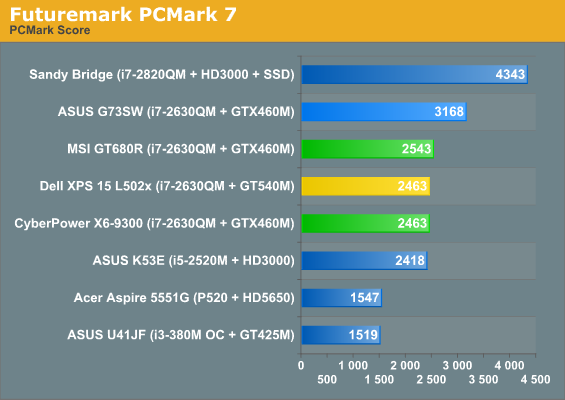
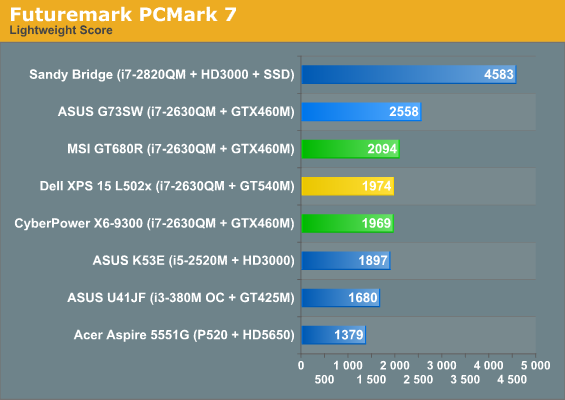
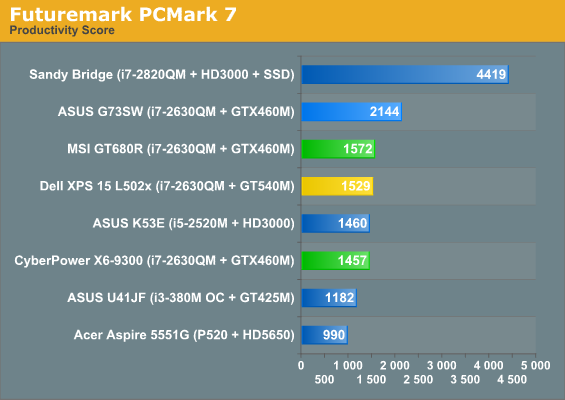
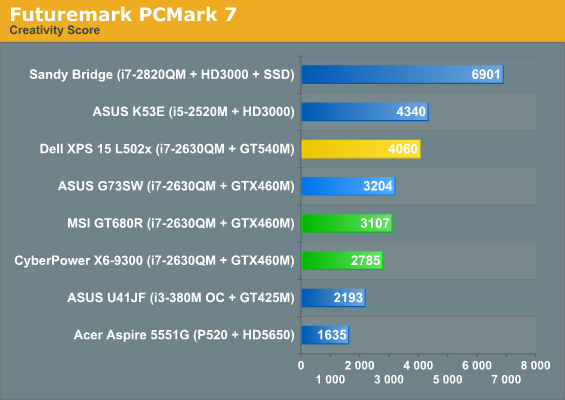
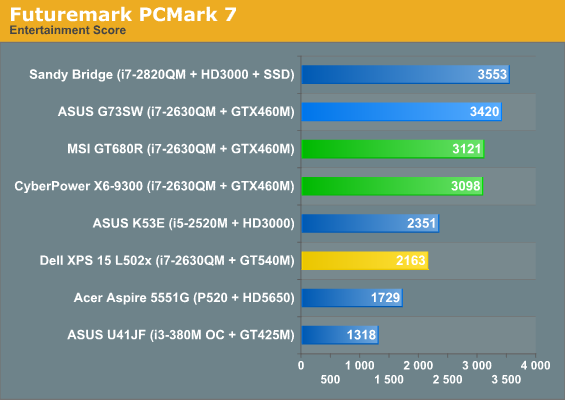
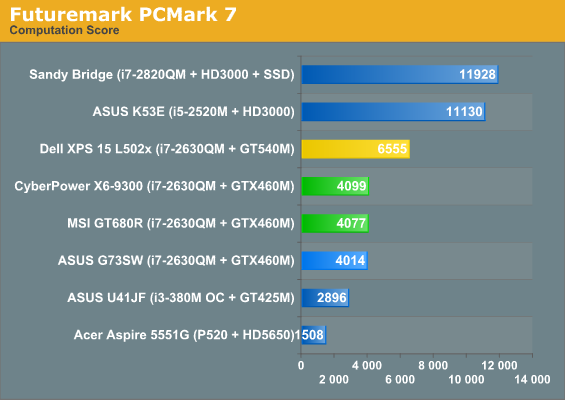
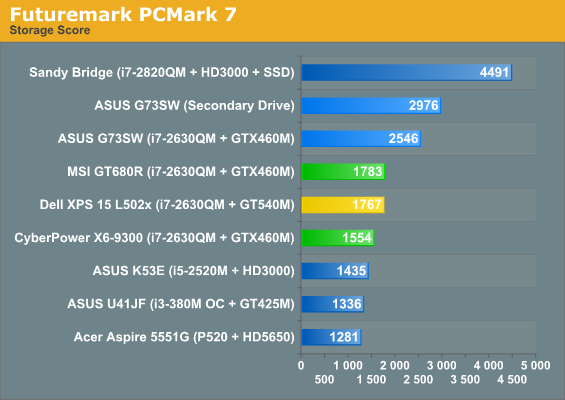
When we first ran PCMark 7, we noticed some oddities: the ASUS G73SW ended up beating the similarly equipped Clevo P151HM, Dell XPS 15 L502x, and MSI GT680R systems by 25%, which is well outside the margin of error we would expect. Looking at the individual test results, we quickly discovered the culprit: the storage subsystem results were around twice as fast on the ASUS compared to the other three laptops. The Dell has a 750GB 7200RPM Western Digital Scorpio Black, whereas the ASUS, Clevo, and MSI notebooks all use the venerable 500GB Seagate Momentus 7200.4; if those three all have the same HDD—heck, the MSI has two of them in RAID 0!—then why are the scores so different?
I decided to pull out the heavy guns on this one and make sure we were playing on a level field; that’s right: I defragged. Actually, I always do that before running benchmarks, but since I had just installed PCMark 7 I thought it was worth a shot. I reran PCMark 7 a couple times to see if some sort of optimization on subsequent runs was coming into play (e.g. SuperFetch). Nope; in fact, the first run on each laptop was usually the highest result out of five runs. After all the testing, I’m still not exactly sure what’s going on. I thought at first that since ASUS has two hard drives, so that might be part of it; however, PCMark 7 let’s you run the storage test on the secondary drive, and I did that as well (and generated an even higher result on the Storage test). A quick look at the ASUS K53E scores shows the same approximate doubling of HDD bandwidth in the various storage subtests, so I have to conclude that ASUS has a BIOS, firmware, or driver optimization that’s giving them a sizeable lead in the PCMark 7 results. Of course, that lead only holds up as long as you’re not looking at the performance of the Sandy Bridge i7-2820QM with an SSD.
In both PCMark 7 and PCMark Vantage (see below), the presence of an SSD definitely makes its presence known. Part of that is because SSDs really do make a system snappier in a lot of ways; the other part of the story is that storage related subtests are in every one of the PCMark 7 suites, with the exception of the Computation benchmark. There’s an interesting element to that test as well, though, in that it has two video transcoding tests, and both appear to use Intel’s Quick Sync when it’s available. The result is that the dual-core and quad-core Sandy Bridge laptops with no discrete graphics come out looking like a champ in that discipline—and they really are fast on video transcoding with the right application. We could force the Dell laptop to run only on the IGP, but interestingly it appears that Quick Sync is only partially used with Optimus. Anyway, don’t get too caught up in the charts, because the large differences in the storage related tests really skew the results.










44 Comments
View All Comments
Hrel - Wednesday, May 18, 2011 - link
So, you want a GT555M? Me too! Check this out: SAGER NP5165 (Clevo W150HR)JarredWalton - Wednesday, May 18, 2011 - link
No, I want at least the performance level of GTX 460M, but with Optimus enabled. :-)zappb - Saturday, May 21, 2011 - link
Jarred - great review as usual - thank you, appreciate your work.I've been looking for a new work machine for awhile with a good screen being the priority - After reading your review, I called the Cyberpower people in the UK - http://www.cyberpowersystem.co.uk/ and am looking to order the X6 - 9300 shortly.
The guy in Cyberpower said that the model has refreshed in the UK with a NVIDIA GeForce GT 555M 2GB GDDR5 instead of the 460. I'm still not sure if it has Optimus enabled, but it should be fairly efficient even without it. I'm hoping this model will also have a lower fan noise because of the slower gfx card.
Apart from the look of the bezel - Assuming the fan noise isn't so bad - then the only real problem in my eyes is the very poor keyboard (which is a problem, but the screen compensates a good deal) - For the price you get a good panel, probably not that far away from a HP Dreamcolour, the 95% FHD display of the W510 / W520 or the Dell M4600 IPS (which is a 400 euro upgrade).
So would the keyboard drive you mad long term?
I was also waiting to see a review of the new M4600 - Have you got your hands on the precision M4600 yet? Insterested in that screen (And the precision will probably have a fantastic keyboard as well) but the price is the problem - probably a net 1k difference in both laptops (of course very different target market and build quality.)
I know it's very strange to bring up the x6 - 9300 vs the Dell M4600 - but I am also so fed up with the quality of laptop screens over the last 6 years, I just want a laptop with a great screen above everything else, followed by price. I will do very little gaming on the x6 - 9300.
Thanks again,
Paul.
JarredWalton - Monday, May 23, 2011 - link
I can live with the Clevo keyboard; I just have to "remap" my brain to using the number keypad for the Home/End/PgUp/PgDn keys. I'm pretty sure the notebook model you're looking at is the Clevo W150HRQ (seen here: http://www.avadirect.com/gaming-laptop-configurato... so it supports Optimus, which means better battery life. The only real question is what LCD they're using -- AVADirect says "glossy", where the P150/P151HM that I've tested both had matte LCDs (neither one from AVADirect, though). If it's the same matte LCD as the P151HM (X6-9300) reviewed here, I'd probably go for it. It's a little slower on the GPU, but better battery life and presumably a slightly lower price.